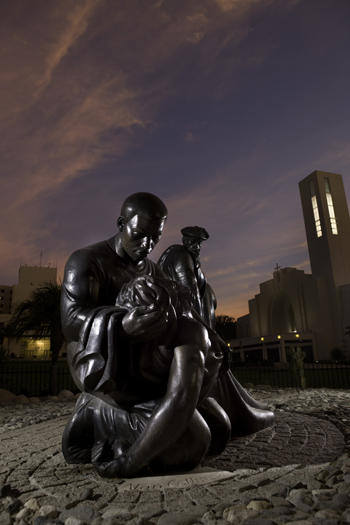Last week’s question asked when the opening ceremonies were held for the Del E. Webb Memorial Library and Randall Visitors Center (now called Randall Amphitheater). The answer is 1981—August 24 specifically. David Brandon
Lori Lawson, and Trish Hughes are our three random winners. Please send an e-mail to pr@llu.edu to claim your prize, which must be picked up within 60 days.
Near the library and also dating to 1981 is the Good Samaritan sculpture, which is a visual representation of Jesus’ parable about the Samaritan who disregarded common prejudices of the day to help a fellow man in need. It was sculpted by Alan Collins and donated by Reuben Matiko, MD, class of 1945, LLU School of Medicine.
The stone sculpture, which took more than four years to complete, was unveiled May 3, 1981. Due to the ravages of Southern California smog, the sculpture deteriorated over time and was eventually reconstructed in bronze.
Today’s question is two-part. What year was the bronze version unveiled, and what type of stone had it originally been made of?
Send the answer to pr@llu.edu by midnight Tuesday, April 15, for a chance to win.
Here are some words from history about the Good Samaritan sculpture.
“The visual arts comprise one of the most effective ways to communicate spiritual concepts, and of these sculpture is the most permanent. Since May 3, 1981, the campus of Loma Linda University has been enhanced by an impressive four-figure sculpture depicting the familiar parable of the Good Samaritan. This is a story of the alchemy of heart, mind and hands, which unfolded as the ‘Good Samaritan,’ emerging from concept to completed masterwork. By day and by night it speaks eloquently to students, practitioners of the healing arts and others who come to worship in the nearby church.
"The Good Samaritan is particularly relevant to the University, whose motto is
‘To Make Man Whole.’ It is the will of the sculptor, Professor Alan Collins, that his interpretation of this parable not only provide an aesthetic experience through the form but, more importantly, point people to Christ as the supreme example of compassion."
–Jean Stewart Boyd, MD, class of 1931, LLU School of Medicine

